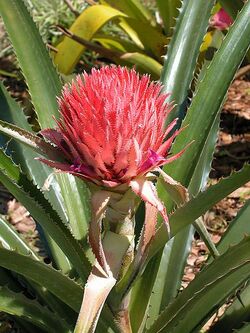Biology:Pseudananas sagenarius
| Pseudananas sagenarius | |
|---|---|

| |
| Scientific classification | |
| Kingdom: | Plantae
|
| (unranked): | |
| (unranked): | Monocots
|
| (unranked): | |
| Order: | |
| Family: | |
| Subfamily: | |
| Genus: | |
| Species: | P. sagenarius
|
| Binomial name | |
| Pseudananas sagenarius (Arruda da Camara) Camargo
| |
Pseudananas sagenarius is a species in the genus Pseudananas. This species is native to Bolivia and Brazil .
Classification
The scientific community is not in consensus on whether this species should belong in Genus Ananas, along with the pineapple and the red pineapple, or belong in its own genus, pseudananas. Ananas sagenaria is the commonly accepted name.[citation needed]
Biology
This plant is found as part of the undergrowth of semi-deciduous and tropical rainforests. Like its close relatives, sagenarius can asexually reproduce by forming offshoots from the mother plant, known by gardeners as suckers. Like members of Ananas, sagenarius forms a multiple fruit, which is a fruit formed from the ovaries of multiple flowers. This fruit is edible, but not as large or desirable of that of the pineapple, and typically contains small seeds which are the main reproductive mode of this plant. This plant is a tetraploid with an extra set of chromosomes, suggesting that this plant's origins may have been a hybrid between a member of genus Ananas and another member of this plant's family, Bromeliaceae.[1][unreliable source?]
Cultivation
This plant is not harvested extensively for its fruit, as the fruit of its cousin the pineapple is much larger and more palatable. It is often used as an ornamental plant for its colorful foliage and as a hedge. This plant is hardier than the pineapple, and can survive light frosts, but will not tolerate very cold winters, being a tropical plant. In these colder climates and in the tropics, this plant is able to be potted and kept as a houseplant.[1][unreliable source?]
References
- Krömer, Thorsten; Kessler, Michael; Holst, Bruce K.; Luther, Harry E.; Gouda, Eric J.; Ibisch, Pierre L.; Till, Walter; Vásquez, Roberto (1 October 1999). "Checklist of Bolivian Bromeliaceae with Notes on Species Distribution and Levels of Endemism" (in en). Selbyana 20 (2): 201–223. ISSN 2689-0682. https://journals.flvc.org/selbyana/article/view/120295.
- Martinelli, Gustavo; Vieira, Cláudia Magalhães; Gonzalez, Marcos; Leitman, Paula; Piratininga, Andréa; Costa, Andrea Ferreira da; Forzza, Rafaela Campostrini (January 2008). "Bromeliaceae da Mata Atlântica Brasileira: lista de espécies, distribuição e conservação" (in pt-BR). Rodriguésia 59 (1): 209–258. doi:10.1590/2175-7860200859114.
- BSI Cultivar Registry Retrieved 11 October 2009
Wikidata ☰ Q15267663 entry

